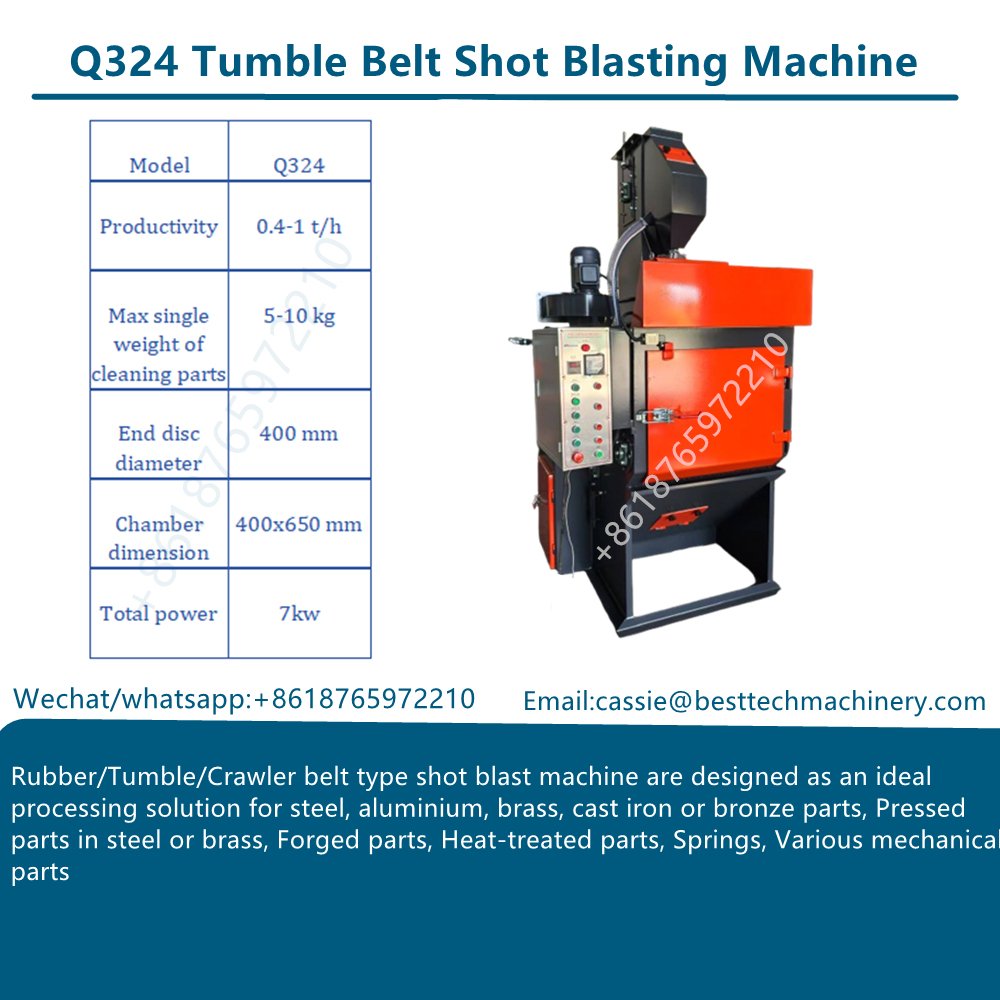Tumble Shot Blaster Introduction
A tumble shot blaster is a specialized industrial machine designed for surface treatment of metal components. It plays a crucial role in foundries, forging plants, and metalworking industries by providing efficient cleaning and polishing solutions for various workpieces.
Definition and Basic Concept
The tumble shot blaster is a type of shot blasting equipment that utilizes a rubber or steel belt conveyor system. It is specifically engineered to process small to medium-sized metal parts through continuous tumbling action while being exposed to high-velocity abrasive media. This unique design ensures uniform surface treatment on all sides of the components.
Key Applications
- Foundry Operations:
- Removal of sand, scale, and oxides from castings
- Preparation of surfaces for painting or coating
- Deburring and edge rounding of metal parts
- Forging Industry:
- Cleaning heat-treated forgings
- Surface preparation for further machining
- General Metalworking:
- Automotive component finishing
- Machinery part surface enhancement
- Construction material treatment
Working Principle
The tumble shot blaster operates through an integrated system:
- Loading System: Parts are automatically fed into the machine
- Tumbling Mechanism: Components rotate continuously on a rubber/steel belt
- Blasting Process: High-speed steel shots or grit are propelled onto surfaces
- Separation System: Used abrasives are separated and recycled
- Unloading: Finished parts exit the machine ready for next processes
Technical Features
- Automated Operation: Minimal manual intervention required
- High Efficiency: Capable of processing large batches continuously
- Versatile Configuration: Available in various sizes and power options
- Environmental Control: Equipped with dust collection systems
Industry Significance and Trends
Tumble shot blasters have become indispensable in modern manufacturing due to:
- Increasing demand for precision surface finishing
- Growing automation in metal processing
- Stricter quality standards in automotive and aerospace sectors
Current development trends include:
- Integration with Industry 4.0 technologies
- Energy-efficient designs
- Improved abrasive recycling systems
- Enhanced safety features

How to Choose the Right Tumble Shot Blaster: A Complete Guide
Selecting the appropriate tumble shot blaster is crucial for achieving optimal surface treatment results in metalworking industries. This guide covers key considerations, model comparisons, application-specific recommendations, and purchasing evaluation points to help you make an informed decision.
1. Key Selection Factors
When choosing a tumble shot blaster, consider the following critical aspects:
a. Equipment Type
- Rubber Belt vs. Steel Belt: Rubber belts are gentler for delicate parts, while steel belts offer durability for heavy-duty applications.
- Conveyor System: Crawler-type systems (e.g., Q326) provide continuous tumbling for uniform blasting516.
b. Automation Level
- Fully automated models reduce manual intervention and improve efficiency. Look for features like automatic loading/unloading and abrasive recycling.
c. Processing Capacity
- Match the machine’s throughput (e.g., small to medium parts) with your production volume. Models like Q3210 handle larger batches.
d. Abrasive Media
- Steel shots or grit are common. Ensure compatibility with your workpiece material (e.g., castings, forgings).
e. Certifications
- CE-approved machines meet safety and environmental standards.
2. Model Comparison
| Model | Key Features | Best For |
|---|---|---|
| Q326 | Rubber belt, automatic loading | Small castings, hardware parts |
| Q3210 | Steel belt, high throughput | Medium-sized forgings |
| 15GN Series | Track-type design, heavy-duty | Large-scale foundries |
3. Application-Specific Recommendations
a. Foundries
- Priority: Sand/scale removal from castings.
- Recommended Models: Q32 series with high cleanliness standards.
b. Forging Plants
- Priority: Heat-treated forging cleaning.
- Recommended Models: Heavy-duty crawler-type blasters (e.g., 15GN Series).
c. General Metalworking
- Priority: Versatility for diverse parts.
- Recommended Models: Q326 for its balance of automation and flexibility.
4. Purchasing Evaluation
a. After-Sales Support
- Opt for suppliers offering lifetime service or at least 1-year warranties.
b. Maintenance Costs
- Factor in abrasive consumption and dust collection system upkeep. Automated models may reduce long-term costs.
c. Customization
- Ensure the machine can be tailored to your workpiece size and production line.
d. Supplier Reputation
- Verify export experience and customer reviews。
Choosing the right tumble shot blaster requires balancing technical specifications, application needs, and budget. Prioritize certified, automated models with robust after-sales support to maximize ROI. For specialized applications, consult suppliers for tailored solutions.
Conclusion
As a vital surface treatment solution, the tumble shot blaster continues to evolve to meet industrial demands. Its combination of efficiency, versatility, and reliability makes it a preferred choice for metal component processing across various sectors. Future advancements will likely focus on smarter controls and more sustainable operation methods.

